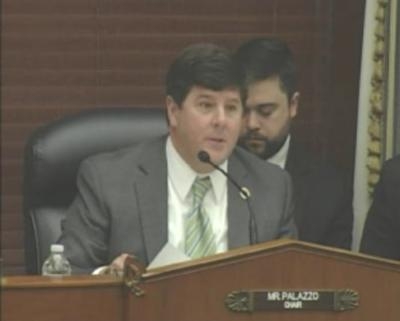Members Question NASA Administrator At Space Subcommittee Hearing On FY 2016 Budget
Members of the Subcommittee on Space today discussed fiscal year 2016 budget priorities with NASA Administrator Charles F. Bolden, Jr. at a hearing last week on the Obama administration’s request. NASA is the world’s leading civilian space agency and the only U.S. federal agency responsible for space exploration.

“NASA is at a crossroads. Unfortunately, the last six years featured drastic change with the cancellation of Constellation and uncertain direction with the president’s ever-changing asteroid initiative," said Space Subcommittee Chairman Steven Palazzo (R-MS) (pictured). "Congress has been consistent in its guidance to NASA that it develop a long-term sustainable exploration strategy that is evolvable and flexible based on an uncertain budget environment. Recent announcements from NASA indicate that the agency is heeding that direction by working towards an architecture that can weather the storms of change that accompany new administrations. Administrator Bolden and his leadership team have a tough job.”
Although President Obama’s FY16 budget request of $18.53 billion includes an increase of $519 million over FY15 appropriated levels, no plans have been proposed to pay for or offset the increase. And despite overall increases, the president’s proposal underfunds the Space Launch System and Orion programs, both necessary for deep-space missions to Mars. The budget proposal would cut these human spaceflight programs by nearly $400 million.
“While there are some areas of agreement between the Committee and the administration in this budget, the president’s request regrettably changes agreed-upon national priorities," said Full House Science Committee Chairman Lamar Smith (R-TX) (pictured, below). "The Obama administration seems to have forgotten NASA’s priorities – and the main one is space exploration. There is a lack of balance in the overall science account request. Congressional guidance and the decadal surveys advocate for a balanced portfolio of science activities. Unfortunately, the president’s request does not adhere to that recommendation by the space experts. One of the most glaring examples is the disproportionate increase in the Earth Science Division that it receives at the expense of other science divisions and human and robotic space exploration.

“There are 13 other agencies involved in climate change research, but only one that is responsible for space exploration. The administration continues to starve NASA’s exploration programs to fund a partisan environmental agenda. NASA simply deserves better.”
In the last eight years, the Obama administration has increased funding for the Earth Science Division by more than 63 percent, while consistently cutting funding for human space exploration programs.
NASA Administrator Charles Bolden (pictured), however, defended those programs. "The most important planet we study is the one on which we live -- Earth," he said.

"Today, 21 NASA-developed research missions orbit Earth and provide a quantitative understanding of our complex planet, its origins and its future. In the last year, we have launched an unprecedented five Earth science missions, starting with the Global Precipitation Measurement Core Observatory (GPM) that already has observed Hurricane Arthur’s brush of the East Coast last July. The Soil Moisture Active Passive (SMAP) mission, launched in January, will give us for the first time ever, a picture of soil moisture on a global scale, allowing scientists to monitor droughts and predict flooding caused by severe rainfall or snowmelt.
"New research missions in formulation include PACE, the Pre-Aerosol, Clouds and ocean Ecosystem continuity mission, that observes ocean color, aerosols, and clouds; NISAR, the NASA-ISRO Synthetic Aperture Radar mission, being developed in partnership with the Indian Space Research Organization to measure complex processes such as ecosystem disturbances and ice-sheet collapse; and CLARREO, the Climate Absolute Radiance and Refractivity Observatory Pathfinder that will begin pre-formulation this fiscal year."
He also cited NASA’s Aeronautics research, which Bolden said "is making air travel cleaner, safer, and more efficient. Every U.S. aircraft and U.S. air traffic control tower has NASA-developed-technology on board. NASA's FY 2016 budget request includes $571.4 million for Aeronautics to fulfill the Agency's strategic research agenda, addressing the most critical challenges facing the aviation sector."
 Sierra Space Repositions Dream Chaser for First Mission
Sierra Space Repositions Dream Chaser for First Mission ANN's Daily Aero-Term (05.10.24): Takeoff Roll
ANN's Daily Aero-Term (05.10.24): Takeoff Roll Aero-News: Quote of the Day (05.10.24)
Aero-News: Quote of the Day (05.10.24) Aero-News: Quote of the Day (05.11.24)
Aero-News: Quote of the Day (05.11.24) ANN's Daily Aero-Term (05.11.24): IDENT Feature
ANN's Daily Aero-Term (05.11.24): IDENT Feature





